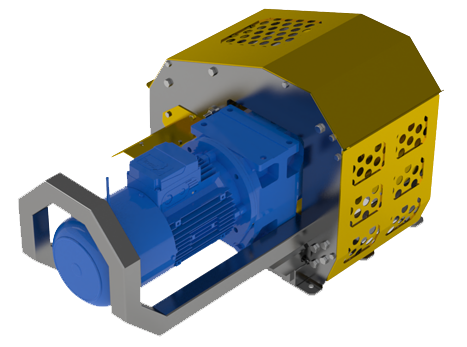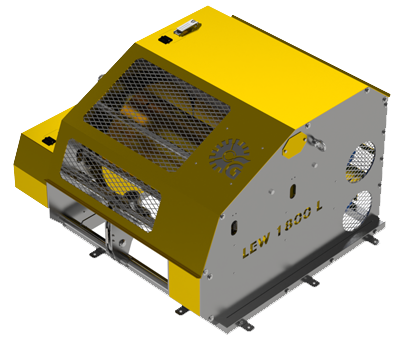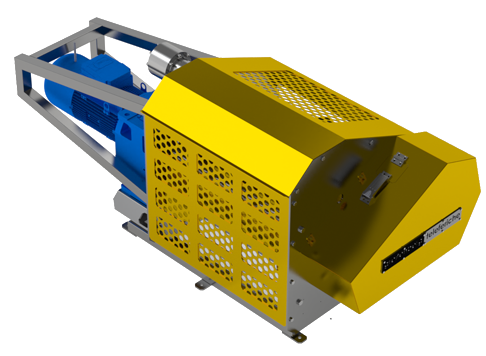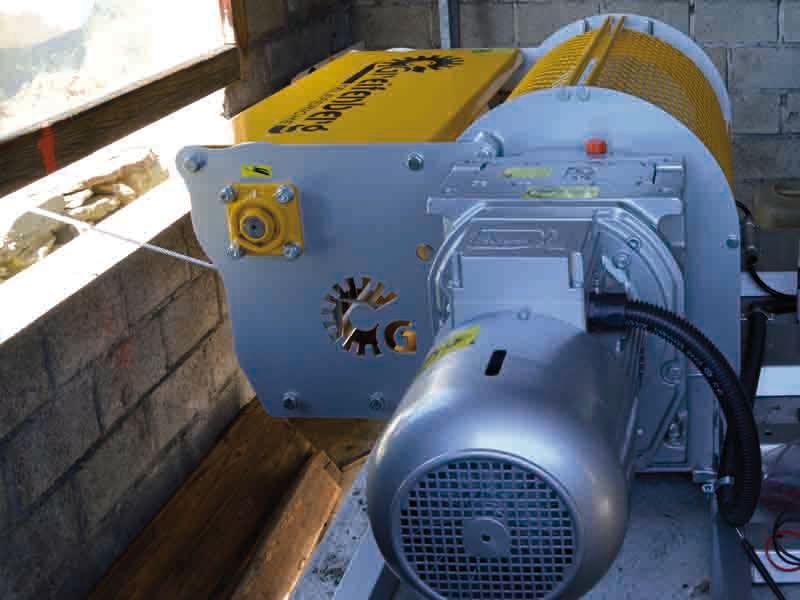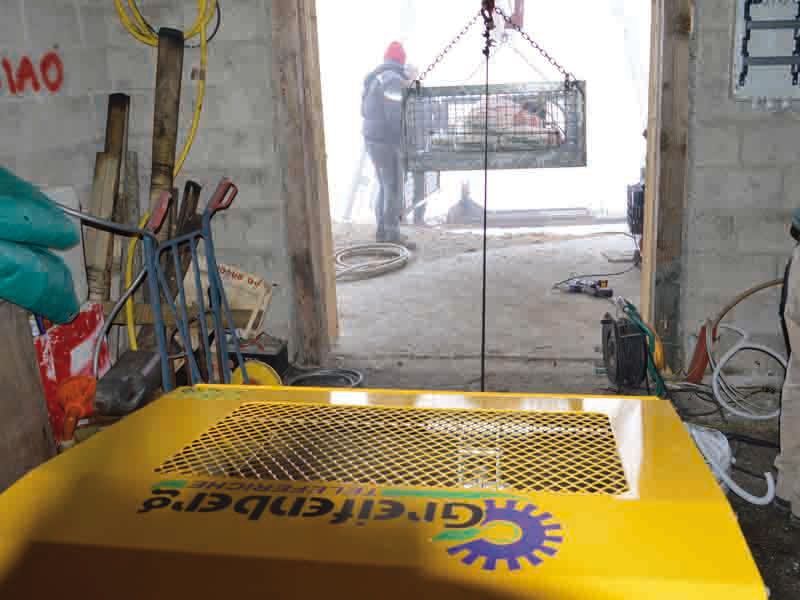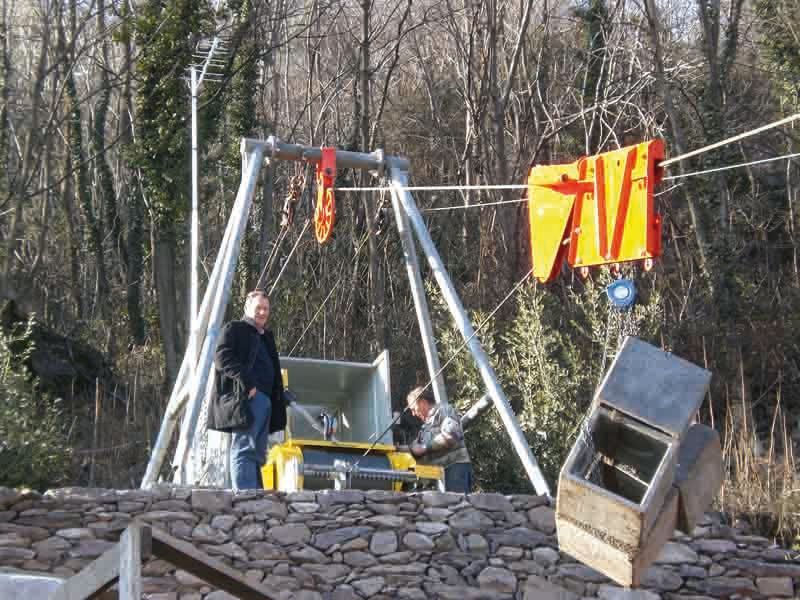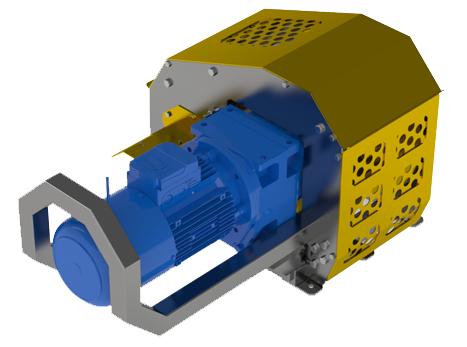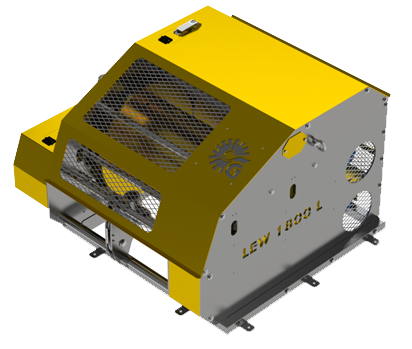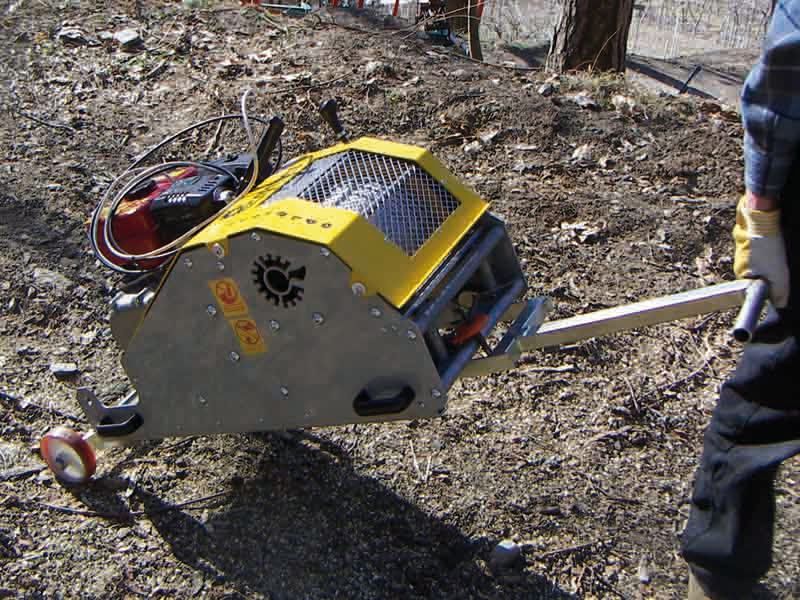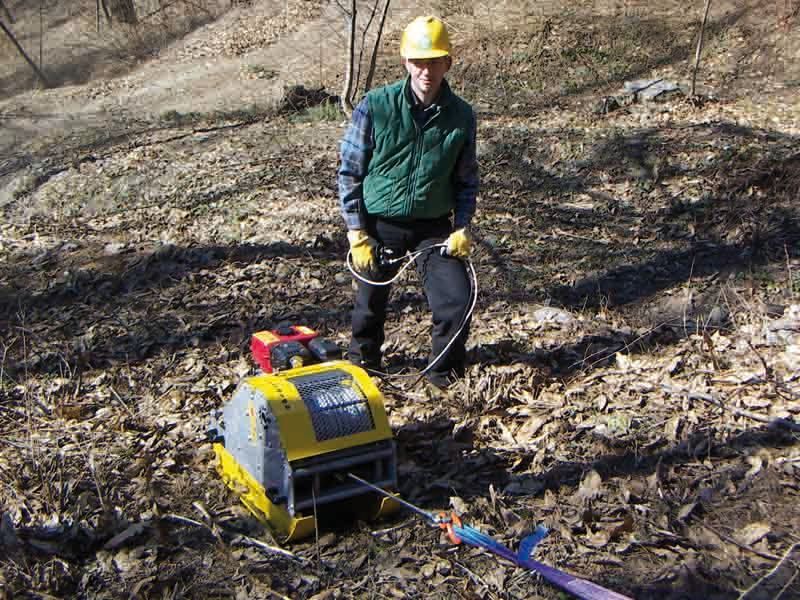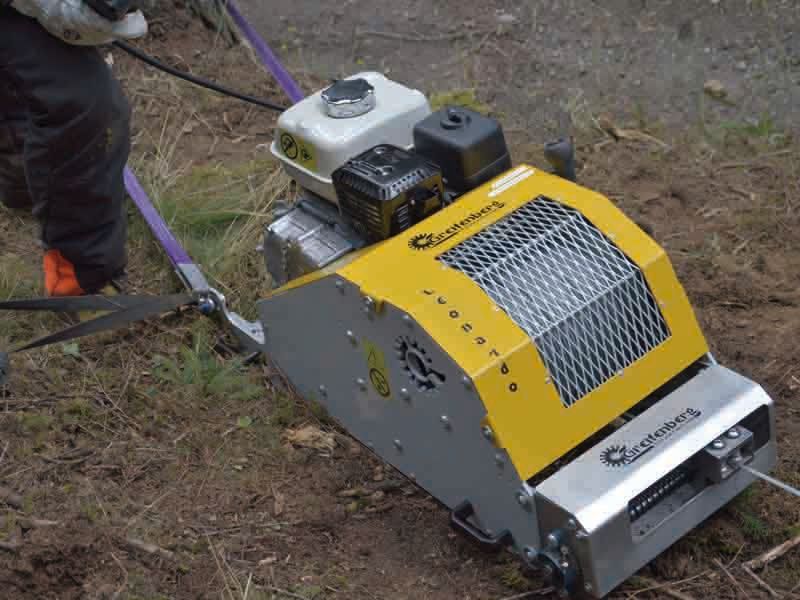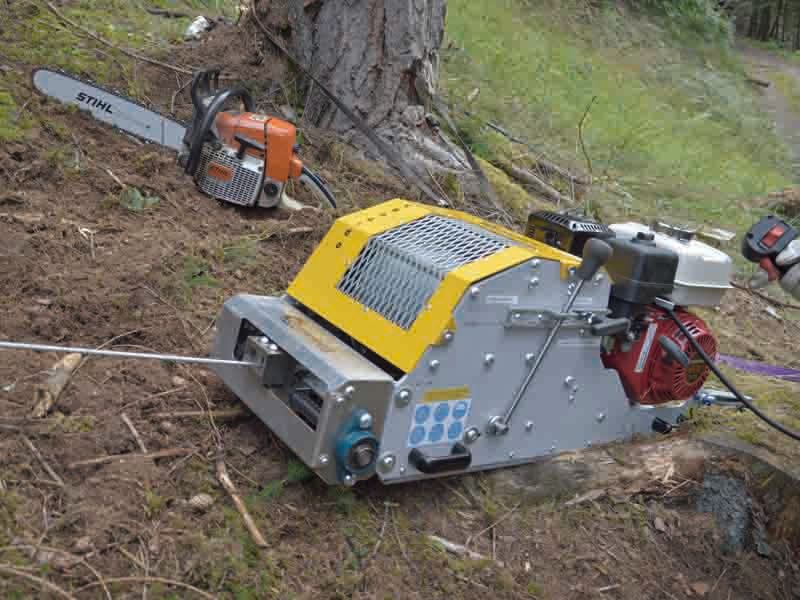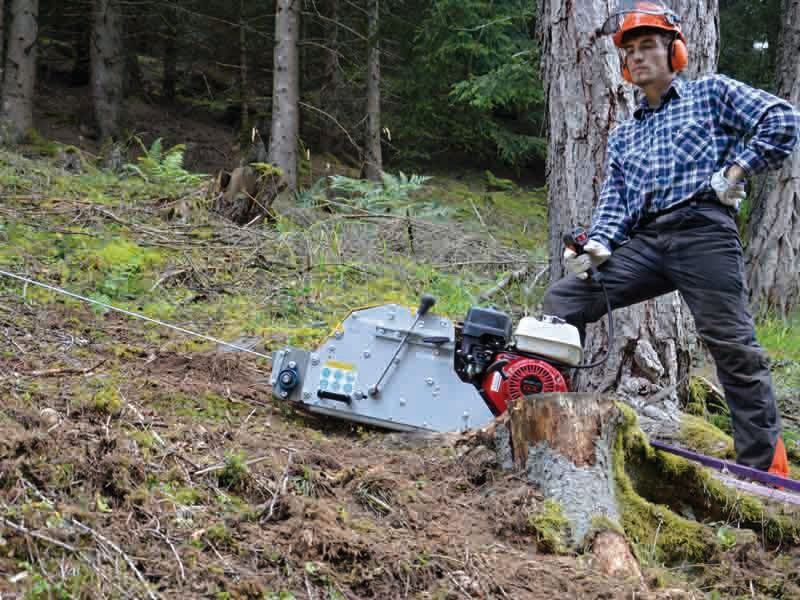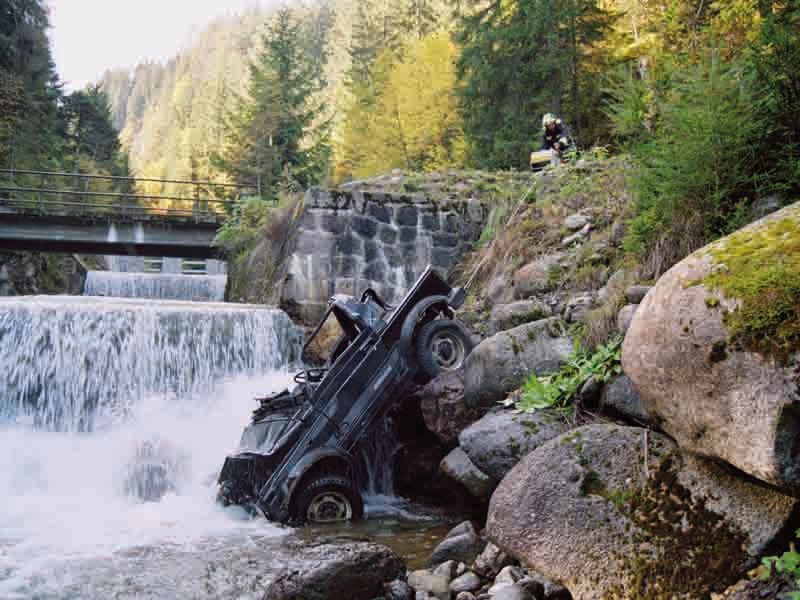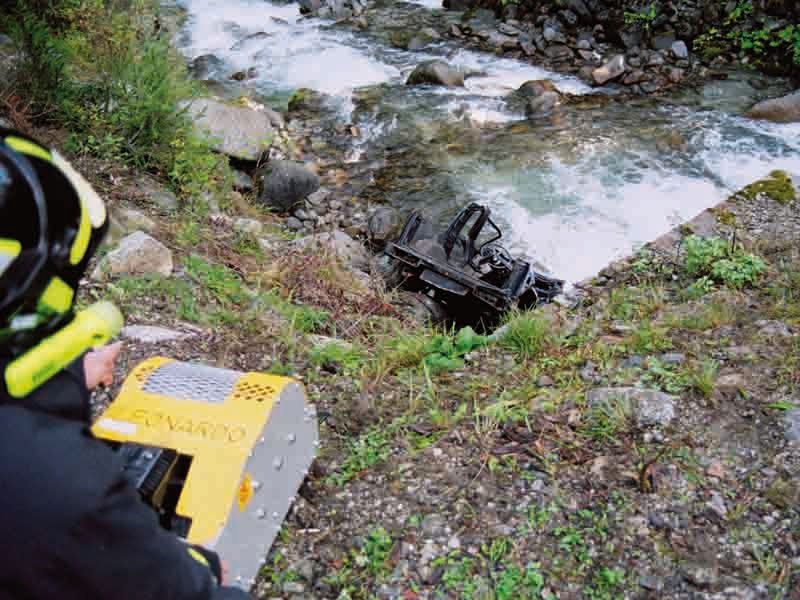Versatile Winches for Every Field of Application
Efficiency and reliability at your service.
Winches for fixed installations serving refuges, mountain huts, villas, construction sites, with power supply from the electrical grid/generator/solar power system. Endless customization options for accessories, line lengths ranging from 200 to 3000 meters, power from 2.2 to 250 KW.
Greifenberg's electric winches are part of the Lew series, distinguished by different performance levels and line lengths, but always customisable to meet every requirement. The Lew-M reaches line lengths up to 1500 metres, with the option to fit electric motors with power ranging from 3 kW at 220 V to 11 kW at 380 V, adapting the winch according to the required pulling force and speed. This winch can be powered by the electrical grid, equipped with an integrated generator, or connected to a photovoltaic system, allowing the speed to vary based on the energy produced.
From the control panel, it is possible to set the upper and lower stations and deceleration points, and through the automatic cycle system, the carriage will proceed autonomously, slowing down or stopping at the previously defined points. The control is via a button panel on the machine, allowing easy initiation of movement while adjusting the working speed, with the display indicating position and speed in real-time. The Lew-M is equipped with safety sensors for over-speed and position beyond set thresholds.
The safety system features a double braking system: a service brake that opens and closes with each use, and an emergency negative brake integrated into the electric motor. The Lew winch is environmentally friendly, limits helicopter transport, and reduces atmospheric and noise pollution. It is the ideal solution for reaching mountain refuges, construction sites, villas, chalets in high-altitude areas, or any location that is inaccessible by road.

A 1200 mm
B 850 mm
C 1900 mm
| TECHNICAL DATA | |||
|---|---|---|---|
| Tipo argano | Electric for fixed installations | ||
| Electric motor power | 5.5 kw 380 V | ||
| Transmission management | Electric drive with inverter | ||
| Over-speed control | Dissipation resistors | ||
| Dry weight | 600 kg | ||
| Dismountable for air transport | 2 parts | ||
| Service brake | Negative brake integrated into the electric motor | ||
| Emergency brake | Direct clamp negative brake on the drum | ||
| RULLO TRAENTE | |||
| Hauling rope capacity and diameter | 1500 m d. 6 mm | 1200 m d. 7 mm | 1000 m d. 8 mm |
| Tensile force at the first layer of the hauling rope | 510 daN | 620 daN | 830 daN |
| Hauling rope traction force at the last layer | 350 daN | 450 daN | 600 daN |
| Maximum speed at the last layer of the hauling rope | 1,3 m/s | 1,0 m/s | 0,7 m/s |
Radio System
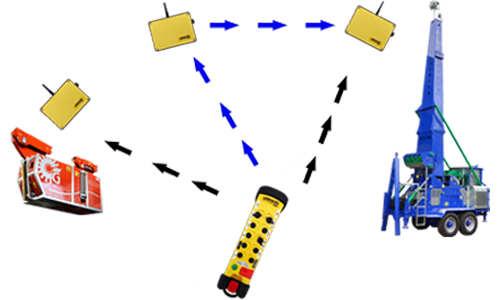
The radio remote controls used by Greifenberg are the result of years of field experience regarding operating capacity and ease of use, and they can be comfortably used with safety gloves. They feature an extremely robust "case" that can withstand drops and violent impacts. With the convenient shoulder strap, they can be operated with one hand, and, thanks to buttons marked with specific icons, manoeuvres during use are extremely simple. A powerful battery ensures a full day’s work, and the standard supply also includes a spare battery and a charger. The "brain" of the radio system is located in the key inserted into the remote control, where codes and communication protocols are stored.
From the remote control, all the manoeuvres normally performed on the machine’s touchscreen panel can be carried out. Indeed, it is possible to switch the diesel engine on and off, increase or decrease the speed of the ropes, set and update the end line or load point, make adjustments beyond the set parameters using the dedicated "by-pass" button, start the automatic work cycle to operate the machine autonomously, control traditional trolleys by opening and closing the rope blocks, and also perform all manoeuvres on motorised trolleys, controlling both the motor and the lifting and lowering speed.
Using the remote control, you can set the maximum lifting point of the trolley to prevent the hook from being mistakenly lifted too high, as well as the maximum rope unwinding, avoiding the entire rope from being unwound from the trolley drum. If the rope is shortened, the maximum lifting point can be reset according to the new length of the rope. The same remote control can also integrate the management of Fortronics electronic chokers with an anti-accidental opening system.
The Radio System includes a perfectly coded and integrated radio frequency repeater. The remote controls can operate with one or more repeaters, making the working distance infinite and, importantly, capable of overcoming bumps, buildings, or any other kind of obstacle, thereby extending the operating range. The repeater is housed in a small, robust casing, and inside it, a powerful rechargeable battery allows operation even during an intense workday. The repeater should be placed at the top of bumps or at the side of structures to ensure good interconnection both with the transmitter and the receiver. The activation is very simple and performed via a single button, with the distance reset at a click.
Greifenberg understands the external working conditions, with temperatures ranging from subzero to scorching sun, snow, water, and humidity. The Radio System is impervious to the elements: IP 65 rating, selected components, contacts treated with anti-oxidant materials—these are the guarantees of a product made for heavy-duty applications. Maximum reliability ensures precise, timely, and irrefutable commands. Transmitters, repeaters, and receivers are ready for non-stop work.
Automatic Cycle
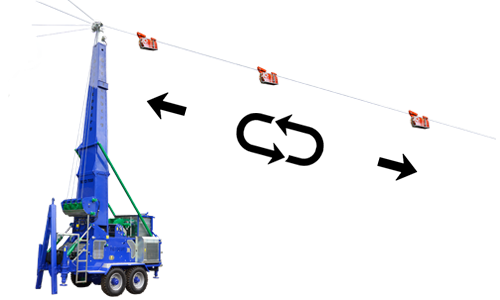
ATG, Automatic Travel Greifenberg, is the electronic control and management system, a true form of artificial intelligence, meaning the machine's ability to perform rope journeys entirely autonomously and in automatic cycle. The ATG system takes into account various critical points such as supports, potential load entanglements, excessive power demand on uphill stretches, overspeeding on descents, deceleration and acceleration speeds, and updates to the loading point if necessary. It constantly coordinates work with reactivity, precision, and accuracy.
To activate the ATG, it is necessary to have the machine recognise the two extreme points of the line, which are stored as "start of line" and "end of line" through an intuitive procedure on the control panel. Subsequently, it will be possible to store points along the line where the supports are located, which will be interpreted as sensitive points. To achieve linear translation, the electronic system allows you to set at what distance from the support you want to slow down and at what distance after passing it, you want to accelerate again and return to the normal speed. The distances and the amount of deceleration can be set differently depending on which direction you are travelling and, consequently, the approach to the supports. In fact, when transporting heavy loads downhill, it is necessary to gradually slow down at a sufficient distance, whereas, once the support is passed, speed is quickly regained to prevent rope and load oscillations. On the other hand, if the transport is uphill, it is enough to slow down close to the support as the weight and gravity already enhance the deceleration.
Everything is under control during the journey. The machine, thanks to its pressure transducers and position encoders, constantly monitors the effort, and if it registers any abnormal spikes (caused by jams or friction), it deactivates the automatic system, stopping the journey but always allowing manual mode to be activated. The ATG function also allows the loading or unloading point to be updated via the radio command. When the transport needs to frequently change the destination point to pick up or drop off materials at different locations, simply activate the “store new end point” function directly from the remote control, and the machine will stop its travel precisely at the designated location.
Colour Display
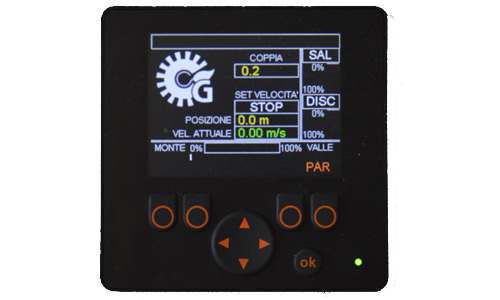
The colour display for machine and line data provides greater accessibility, instant visual understanding, and easy parameterisation of the line, as well as a simplified procedure for synchronising the remote controls of the trolleys. The new series of displays allows for quick checks, providing constant information to the operator about the position, effort, position of the shoes, engine revolutions, fuel consumption, and fuel levels. The most important data is displayed both analogically and digitally to enhance the immediacy of reading.
Air transportable
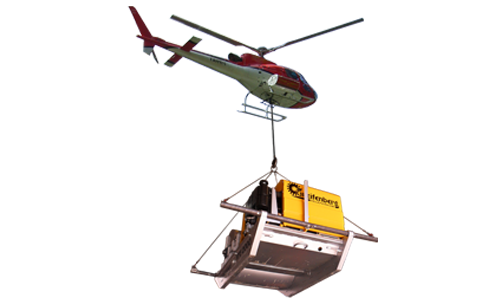
Greifenberg machines and equipment that need to reach work positions without communication routes are designed with modular sections for quick disassembly, allowing the creation of units with a weight of less than 1100 kg. This feature makes it possible to transport them using conventional helicopters. Air transport reduces installation times, and the disassembly/assembly systems of the individual modules are designed to be simple, enabling the team to move the equipment quickly and safely.
Backup Alarm
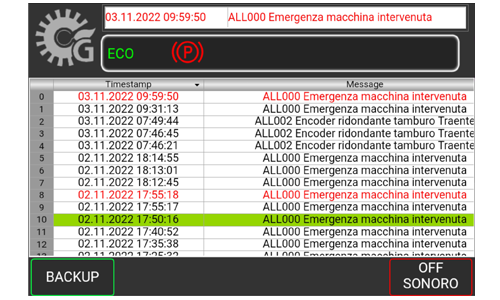
Total control, verification, and statistics. Every alarm, abnormal use, and operation outside the parameters are automatically recorded and stored in a dedicated memory. Data such as engine over-revving, overpressures, overspeed, oil and water temperature alarms, etc., are immediately recorded. It will be easy for the owner to monitor how the machine is used, both by their own staff and in the case of rental to third parties. Even for technical service interventions, everything becomes faster, limiting management costs. Information serving the durability and maintenance.
Remote Assistance
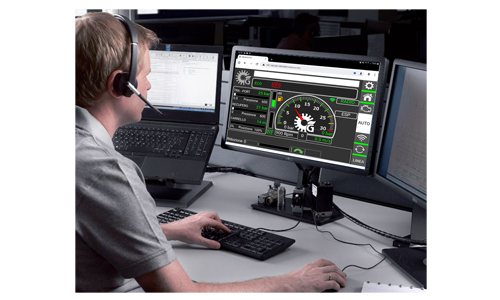
Our technicians with you, whenever you need, at your site to help you solve problems. Through remote assistance, simply activate a GPRS connection and allow access to your equipment. This always happens and exclusively with the operator's authorisation to the machine. Once connected, our electronic and hydraulic technicians can work on the machine as if they were right there on site. Maximum intervention speed and reduction of costs and waiting times. The innovation of safety always by your side.
Lew-S is the electric winch from Greifenberg that reaches distances of up to 350 metres. Like the entire Lew series, it lends itself to infinite configuration solutions, with motor power ranging from 2.2 kW to 5.5 kW, available in either 220V or 380V options. The power supply can come from the electrical grid, an integrated generator, or energy produced by photovoltaic panels. The Lew range is designed for the construction of fixed installations where the need to transport materials via cable is essential to reach alpine refuges, mountain huts, building sites, and maritime cliffs.
The excellence of this series lies in combining practical aspects with safety devices and cableway monitoring systems. Lew-S features ground anchorage to ensure structural stability, a control unit for safety management, and can be operated via buttons on the electrical panel or, upon request, using a pushbutton or remote control. An onboard display constantly informs the operator about the winch's status, such as speed and position; the automatic cycle function can be enabled, where the winch recognises the top station, the bottom station, and the support points where the trolley slows down according to the preset parameters.
One of the added values of Lew-S is undoubtedly its safety system, with a direct action brake operated by the user and electrical limit switches for safety. The addition of the automatic rope guide ensures the rope stays in the correct position on the winch drum. Tele-assistance facilitates remote technical support, and there are many extra accessories available to optimise the performance of this winch.

A 1250 mm
B 550 mm
C 970 mm
| TECHNICAL DATA | |||
|---|---|---|---|
| Winch type | Electric for fixed installations | ||
| Electric motor power | 4 kw 380 V | ||
| Transmission management | Electric drive with inverter | ||
| Over-speed control | Dissipation resistors | ||
| Dry weight | 290 kg | ||
| Service brake | Negative brake integrated into the electric motor | ||
| PULLING DRUM | |||
| Hauling rope capacity and diameter | 350 m d. 5 mm | 260 m d. 6 mm | 200 m d. 7 mm |
| Tensile force at the first layer of the hauling rope | 220 daN | 330 daN | 430 daN |
| Hauling rope traction force at the last layer | 180 daN | 260 daN | 340 daN |
| Maximum speed at the last layer of the hauling rope | 1,8 m/s | 1,3 m/s | 1,0 m/s |
Radio System

The radio controls used by Greifenberg are the result of years of field experience concerning operating range and ease of use. They are comfortably usable with safety gloves and feature an extremely robust “case” that can withstand drops and heavy impacts. With the convenient shoulder strap, they can be operated with one hand, and, thanks to buttons marked with specific icons, manoeuvres during use are extremely simple. A powerful battery ensures a full day of operation, and the standard supply also includes a spare battery and a charger. The brain of the radio system is located in the key inserted into the remote control, where codes and communication protocols are stored.
From the remote control, it is possible to perform all the manoeuvres that are normally carried out via the machine’s touch screen panel. In fact, it allows the ignition and turning off of the diesel engine, speeding up and slowing down the rope, setting and updating the end-of-line or loading point, performing movements outside the preset parameters via the dedicated “by-pass” button, starting the automatic work cycle for autonomous machine operation, controlling traditional trolleys by opening and closing blocks on the ropes, and even performing all manoeuvres on the motorised trolleys by controlling both the motor and lifting/lowering speed. Through the remote control, it is possible to set the maximum lifting point of the trolley to prevent the hook from being lifted too much, as well as the maximum rope payout, avoiding unspooling the entire rope wound on the trolley drum. If the rope is shortened, it is possible to reset the maximum lifting point to the new rope length. The same remote control can also integrate the management of Fortronics electronic chokers with an anti-accidental opening system.
The Radio System includes a perfectly coded and integrated radio frequency repeater. The remote controls can operate with one or more repeaters, making the working distance virtually infinite and, above all, capable of overcoming bumps, buildings, and any type of obstacles, extending operational distances. The repeater is housed in a compact, robust casing, and inside, a powerful rechargeable battery enables it to work throughout an intense working day. The repeater should be positioned at the top of bumps or beside structures to ensure good interconnection with both the transmitter and receiver. The activation is very simple and is performed by pressing a single button, with the distance reset by a click.
Greifenberg understands the external working conditions, with temperatures ranging from sub-zero to scorching sun, snow, water, and humidity. The Radio System is impervious to the weather: it is rated IP65, uses selected components, and has contacts treated with anti-oxidising materials. These are the guarantees of a product designed for heavy-duty use. Maximum reliability to ensure precise, timely, and unquestionable control. Transmitters, repeaters, and receivers are ready for non-stop work.
Automatic Cycle

ATG, Automatic Travel Greifenberg, is the electronic control and management system, a true artificial intelligence, meaning the ability of the machine to perform rope journeys autonomously and in automatic cycle. The ATG system takes into account various critical points such as supports, possible load snags, excessive power demand on uphill sections, overspeeding during descents, deceleration and acceleration speeds, and the updating of the loading point when necessary. It constantly coordinates the work with reactivity, precision, and accuracy.
To activate the ATG, the two extreme points of the line must first be recognised by the machine, which are then stored as "start of line" and "end of line" through an intuitive procedure on the control panel. Subsequently, it will be possible to store the points along the line where the supports are located, which will be interpreted as sensitive points. To ensure smooth travel, the electronic system allows for setting the distance from the support at which we want to slow down and the distance at which, after passing the support, we want to accelerate and return to normal speed. The distances and the number of decelerations can be entered differently depending on which direction the journey is taking and the approach to the supports. For example, when carrying heavy loads downhill, it is necessary to slow down gradually at a suitable distance, and once past the support, speed is quickly increased to avoid rope and load oscillations. On the other hand, when transporting uphill, it is sufficient to slow down close to the support, as the weight and gravity already provide deceleration.
Everything is under control during the journey, as the machine, thanks to its pressure transducers and position encoders, constantly monitors the effort, and if it detects abnormal peaks (caused by jams or resistance), it deactivates the automatic system, stopping the journey while always allowing manual mode to remain available. The ATG function also allows for updating the loading or unloading point via the radio control. When the transport point needs to change frequently to collect or deposit material in different locations, simply activate the "store new end point" function directly from the remote control, and the machine will stop at the exact determined location.
Colour Display

The colour display for machine and line data provides greater accessibility, instant visual understanding, and easy parameterisation of the line, as well as a simplified procedure for synchronising the remote controls of the trolleys. The new series of displays allows for quick checks, providing constant information to the operator about the position, effort, position of the shoes, engine revolutions, fuel consumption, and fuel levels. The most important data is displayed both analogically and digitally to enhance the immediacy of reading.
Backup Alarm

Total control, verification, and statistics. Every alarm, abnormal use, and operation outside the parameters are automatically recorded and stored in a dedicated memory. Data such as engine over-revving, overpressures, overspeed, oil and water temperature alarms, etc., are immediately recorded. It will be easy for the owner to monitor how the machine is used, both by their own staff and in the case of rental to third parties. Even for technical service interventions, everything becomes faster, limiting management costs. Information serving the durability and maintenance.
Remote Assistance

Our technicians with you, whenever you need, at your site to help you solve problems. Through remote assistance, simply activate a GPRS connection and allow access to your equipment. This always happens and exclusively with the operator's authorisation to the machine. Once connected, our electronic and hydraulic technicians can work on the machine as if they were right there on site. Maximum intervention speed and reduction of costs and waiting times. The innovation of safety always by your side.
The Lew-L electric winch has been designed to combine robustness with great versatility: it can be powered by the electrical grid, equipped with an integrated generator, or harness energy from photovoltaic panels. In this way, the advancement speed is directly related to the energy production. The Lew series can be customised, starting with the choice of the electric motor, which ranges from 3 kW to 11 kW, the line length, which in the standard version reaches up to 3000 metres, and the control system via either a push-button panel or a remote control. It also offers many additional accessories that complete and enhance the entire system.
The Lew-L safety system includes a display that constantly informs the operator, a control unit for managing the controls, electric limit switches, a negative emergency brake that can be manually activated via panic-stop or automatically through the intervention of safety sensors, and also a service brake that opens and closes with each use.
From the control panel, the operator can set the top and bottom stations and various deceleration points for fully autonomous operation. Lew is the solution that provides a sustainable service, reduces supply costs, minimises the need for a helicopter, respects the environment, and eliminates pollution and noise. It transports materials during maintenance and renovation works, supplies mountain huts with food and emergency materials, and Lew is the ally that supports work at height.

A 1600 mm
B 1200 mm
C 1400 mm
| TECHNICAL DATA | |||
|---|---|---|---|
| Winch type | Electric for fixed installations | ||
| Electric motor power | 11 kw 380 V | ||
| Transmission management | Electric drive with inverter | ||
| Over-speed control | Dissipation resistors | ||
| Dry weight | 860 kg | ||
| Dismountable for air transport | 2 parts | ||
| Service brake | Negative brake integrated into the electric motor | ||
| Emergency brake | Direct clamp negative brake on the drum | ||
| PULLING DRUM | |||
| Hauling rope capacity and diameter | 3000 m d. 6 mm | 2400 m d. 7 mm | 1700 m d. 8 mm |
| Tensile force at the first layer of the hauling rope | 510 daN | 620 daN | 830 daN |
| Hauling rope traction force at the last layer | 350 daN | 450 daN | 600 daN |
| Maximum speed at the last layer of the hauling rope | 2,4 m/s | 1,9 m/s | 1,5 m/s |
Radio System

The radio controllers used by Greifenberg are the result of years of field experience concerning operational range and ergonomic use. They are comfortably usable with safety gloves and feature an extremely robust "case" capable of withstanding drops and violent impacts. With the convenient shoulder strap, they can be held with one hand, and thanks to buttons marked with specific icons, operations during use are incredibly simple. A powerful battery ensures a full day of work, and the standard supply also includes a spare battery and a charger. The brain of the radio system is located in the key inserted into the remote control, where codes and communication protocols are stored.
From the remote control, it is possible to perform all the operations normally carried out from the machine's touchscreen panel. In fact, it is possible to turn the diesel engine on and off, increase or decrease the speed of the cables, set and update the end line or loading point, make movements outside the set parameters via the dedicated "bypass" button, start the automatic work cycle by making the machine operate autonomously, control traditional trolleys by opening and closing the blocks on the cables, and also perform all operations on motorised trolleys by controlling both the motor and the lifting and lowering speed. Through the remote control, it is possible to set the maximum lifting point of the trolley to prevent the hook from being raised too much, as well as the maximum unwinding of the cable, avoiding unwinding the entire cable wrapped on the trolley's drum. If the cable is shortened, it is possible to reset the maximum lifting point, updating it to the new length of the cable. The same remote control can also integrate the management of Fortronics electronic chokers with an anti-accidental-opening system.
The Radio System includes a perfectly coded and integrated radio frequency repeater. The radio controllers can operate with one or more repeaters, allowing the working distance to be infinite and, most importantly, capable of overcoming bumps, buildings, and obstacles of any kind, thereby extending the operational range. The repeater is housed in a small, sturdy casing, and inside, a powerful rechargeable battery ensures operation even during an intense working day. The repeater should be placed at the peaks of bumps or beside the structures so that it establishes a good connection both with the transmitter and the receiver. The activation is very simple, carried out with a single button, and the distance is reset with one click.
Greifenberg understands the external working conditions, with temperatures ranging from below freezing to scorching sun, snow, water, and humidity. The Radio System is not affected by the elements: with an IP65 rating, selected components, and contacts treated with anti-oxidant materials, these are the guarantees of a product designed for heavy-duty work. Maximum reliability ensures precise, timely, and irrefutable commands. Transmitters, repeaters, and receivers are ready for uninterrupted work.
Automatic Cycle

ATG, Automatic Travel Greifenberg, is the electronic control and management system, a true form of artificial intelligence, meaning the machine's ability to carry out cable journeys completely autonomously and in automatic cycle. The ATG system takes into account various critical points such as supports, potential load entanglements, excessive power demand when climbing, over-revving during descents, deceleration and acceleration speeds, and the updating of the loading point if necessary. It constantly coordinates the work with reactivity, precision, and accuracy.
To activate the ATG, the two extreme points of the line must first be recognised by the machine, which are then stored as the "start of line" and "end of line" using an intuitive procedure on the control panel. Subsequently, it will be possible to store the points along the line where the supports are located, which will be interpreted as sensitive points. To achieve a smooth translation, the electronic system allows you to set at which distance from the support you want to slow down and at which distance after passing the support you want to reaccelerate and return to normal speed. Distances and the amount of deceleration can be set differently depending on the direction of travel and the entry to the supports. In fact, when transporting heavy loads downhill, it is necessary to gradually slow down at a proper distance, while after passing the support, speed is quickly regained to prevent cable and load oscillation. Conversely, if the transport is going uphill, it is sufficient to slow down near the support, as the weight and gravity already help to decelerate.
Everything is under control during the journey; in fact, the machine, thanks to its pressure transducers and position encoders, constantly monitors the effort, and if it detects abnormal peaks (caused by jamming or resistance), it deactivates the automatic system, stopping the journey, but always making it available in manual mode. The ATG function also allows you to update the loading or unloading point via the radio control. When transport needs to change the arrival point frequently to pick up or drop off material at different locations, simply activate the "store new end point" function directly from the remote control, and the machine will stop its journey exactly at the specified location.
Colour Display

The colour display for machine and line data provides greater accessibility, better intuition at first glance, ease of line parameterisation, and a simplified procedure for synchronising the trolley remote controls. The new series of displays allows quick checks, providing the operator with constant updates on position, effort, shoe position, motor rotations, fuel consumption, and fuel levels. The most important data is displayed both in analogue and digital formats to enhance the immediacy of reading.
Air transportable

Greifenberg machines and equipment that need to reach work positions without communication routes are designed with modular sections for quick disassembly, allowing the creation of units with a weight of less than 1100 kg. This feature makes it possible to transport them using conventional helicopters. Air transport reduces installation times, and the disassembly/assembly systems of the individual modules are designed to be simple, enabling the team to move the equipment quickly and safely.
Backup Alarm

Total control, verification, and statistics. Every alarm, abnormal use, and operation outside the parameters are automatically recorded and stored in a dedicated memory. Data such as engine over-revving, overpressures, overspeed, oil and water temperature alarms, etc., are immediately recorded. It will be easy for the owner to monitor how the machine is used, both by their own staff and in the case of rental to third parties. Even for technical service interventions, everything becomes faster, limiting management costs. Information serving the durability and maintenance.
Remote Assistance

Our technicians with you, whenever you need, at your site to help you solve problems. Through remote assistance, simply activate a GPRS connection and allow access to your equipment. This always happens and exclusively with the operator's authorisation to the machine. Once connected, our electronic and hydraulic technicians can work on the machine as if they were right there on site. Maximum intervention speed and reduction of costs and waiting times. The innovation of safety always by your side.
The Lew series represents the electric winches produced by Greifenberg, specially designed for rope transport services in alpine huts, construction sites, villas, mountain cabins, or any location that is inaccessible by road. Lew offers infinite customisation possibilities, including line length, electric motor power, and many optional features that characterise the entire system.
Lew-XS is the smallest in the series, based on the same frame as our Leonardo model, but transformed into a true electric winch capable of reaching lines up to 200 metres. Lightweight, compact, discreet, and easy to install, it adapts to any situation. It can operate at 220V using standard household power, or at a higher voltage of 380V to enhance performance. The electric motor can vary within the range of 2.2 kW to 5.5 kW, depending on the required performance. Additionally, there is the option to connect Lew-XS to an existing photovoltaic system, with the advantage of adjusting the machine’s speed according to energy production.
The safety system includes a service brake for opening and closing with each use, and an integrated emergency negative brake within the electric motor. The controls are positioned on the electrical panel, with the option to include a remote control with the same functions. Lew-XS can be equipped with a front rope guide to assist with correct rope winding, a display on the panel that informs the user of the machine’s parameters, an automatic cycle system that stores the entire line with start/end points, and any intermediate slowing supports to enable autonomous operation, as well as remote assistance that enhances diagnostics from a distance.

A 830 mm
B 420 mm
C 600 mm
| TECHNICAL DATA | |
|---|---|
| Winch type | Electric for fixed installations |
| Electric motor power | 2.2 kw 220 V - 3 kw 380 V |
| Transmission management | Electric drive with inverter |
| Over-speed control | Dissipation resistors |
| Dry weight | 90 kg |
| Service brake | Negative brake integrated into the electric motor |
| PULLING DRUM | |
| Hauling rope capacity and diameter | 200 m d. 5 mm |
| Tensile force at the first layer of the hauling rope | 500 - 690 daN |
| Hauling rope traction force at the last layer | 360 - 495 daN |
| Velocità massima ultimo strato fune traente | 0,5 m/s |
Radio System

The remote controls adopted by Greifenberg are the result of years of field experience regarding operational range and ease of use. They are comfortably usable with safety gloves, and feature an extremely robust "case" that can withstand drops and violent impacts. With the convenient shoulder strap, they can be held with one hand, and thanks to the buttons marked with specific icons, manoeuvres during use are extremely simple. A powerful battery guarantees a full day of work, and the standard supply also includes a spare battery and a charger. The brain of the radio system is located in the key inserted into the remote control, where codes and communication protocols are stored.
From the remote control, it is possible to perform all the manoeuvres that are usually carried out from the machine's touchscreen panel. For example, it is possible to turn the diesel engine on and off, increase and decrease the speed of the ropes, set and update the end line or loading point, make adjustments outside the set parameters using the dedicated "bypass" button, start the automatic work cycle for autonomous machine operation, control traditional trolleys by opening and closing the blocks on the ropes, and also perform all manoeuvres on motorised trolleys, controlling both the motor and the speed of lifting and lowering.
Using the remote control, it is possible to set the maximum lifting point of the trolley to ensure the hook is not accidentally raised too high, as well as the maximum rope unwinding, preventing the entire rope from being unwound from the drum of the trolley. If the rope is shortened, the maximum lifting point can be reset to the new rope length. The remote control can also integrate the management of Fortronics electronic chokers with an anti-accidental-opening system.
The Radio System includes a perfectly coded and integrated radio frequency repeater. The remote controls can operate with one or more repeaters, extending the working distance infinitely and, above all, allowing it to overcome bumps, buildings, and obstacles of any kind, increasing the operational range. The repeater is housed in a robust, small-sized casing, with a powerful rechargeable battery that ensures operation even during a full working day. The repeater should be placed at the peaks of bumps or beside structures to ensure a good connection with both the transmitter and the receiver. Activation is very simple, performed via a single button, and the distance is reset with one click.
Greifenberg understands the external working conditions, with temperatures ranging from sub-zero to intense sun, snow, water, and humidity. The Radio System is weatherproof: with an IP65 rating, selected components, and contacts treated with anti-oxidant materials. These are the guarantees of a product designed for heavy-duty use. Maximum reliability to ensure precise, timely, and unequivocal commands. Transmitters, repeaters, and receivers are ready for continuous work.
Automatic Cycle

ATG, Automatic Travel Greifenberg, is the electronic control and management system, a true artificial intelligence, meaning the machine's ability to carry out rope travel autonomously and in automatic cycle. The ATG system considers various critical points, such as supports, any entanglements of the load, excessive power demand on the ascent, overspeed on descents, deceleration and acceleration speeds, and the update of the loading point if necessary. It constantly coordinates the operation with responsiveness, precision, and accuracy.
To activate the ATG, it is necessary to make the machine recognise the two end points of the line, which are then stored as "start of line" and "end of line" through an intuitive procedure on the control panel. It is then possible to store the points along the line where the supports are located, which will be interpreted as sensitive points. To achieve a smooth translation, the electronic system allows you to set the distance from the support at which you want to slow down and the distance after passing the support at which you want to accelerate again and return to the normal speed. The distances and the amount of deceleration can be set differently depending on which part of the journey is being undertaken and the direction of travel relative to the supports. Indeed, when transporting heavy loads downhill, it is necessary to gradually slow down at a proper distance, and once the support is passed, speed is quickly regained to avoid rope and load oscillations. On the other hand, if the transport is uphill, it is enough to slow down near the support, as the weight and gravity already assist with deceleration.
Everything is under control during the journey, as the machine, thanks to its pressure transducers and position encoders, constantly monitors the effort. If it detects abnormal peaks (caused by blockages or contrasts), it deactivates the automatic system, stopping the journey but always keeping manual mode available. The ATG function also allows for updating the loading or unloading point via radio control. When the transport needs to frequently change the destination point to pick up or drop off material in different locations, it will be enough to directly activate the "store new end point" function from the remote control, and the machine will stop its travel exactly at the designated place.
Colour Display

The colour display for machine and line data offers greater accessibility, improved intuition at first glance, ease of line parameterisation, and a simplified procedure for synchronising the remote controls of the trolleys. The new series of displays enables rapid checks, constantly informing the operator of the position, effort, position of the shoes, motor revolutions, consumption, and fuel levels. The most important data are displayed both analogically and digitally to enhance the immediacy of reading.
Backup Alarm

Total control, verification, and statistics. Every alarm, abnormal use, and operation outside the parameters are automatically recorded and stored in a dedicated memory. Data such as engine over-revving, overpressures, overspeed, oil and water temperature alarms, etc., are immediately recorded. It will be easy for the owner to monitor how the machine is used, both by their own staff and in the case of rental to third parties. Even for technical service interventions, everything becomes faster, limiting management costs. Information serving the durability and maintenance.
Remote Assistance

Our technicians with you, whenever you need, at your site to help you solve problems. Through remote assistance, simply activate a GPRS connection and allow access to your equipment. This always happens and exclusively with the operator's authorisation to the machine. Once connected, our electronic and hydraulic technicians can work on the machine as if they were right there on site. Maximum intervention speed and reduction of costs and waiting times. The innovation of safety always by your side.

CONTACT US FOR CONSULTATION
Don’t miss the opportunity to ensure the maximum quality and safety for your equipment! Contact us today for a personalized consultation and discover the effectiveness of our trolleys and original Greifenberg spare parts.
Contattaci
Thank you for contacting us.
We will reply as soon as possible.
An error occurred while sending the message.
Please try again later.





